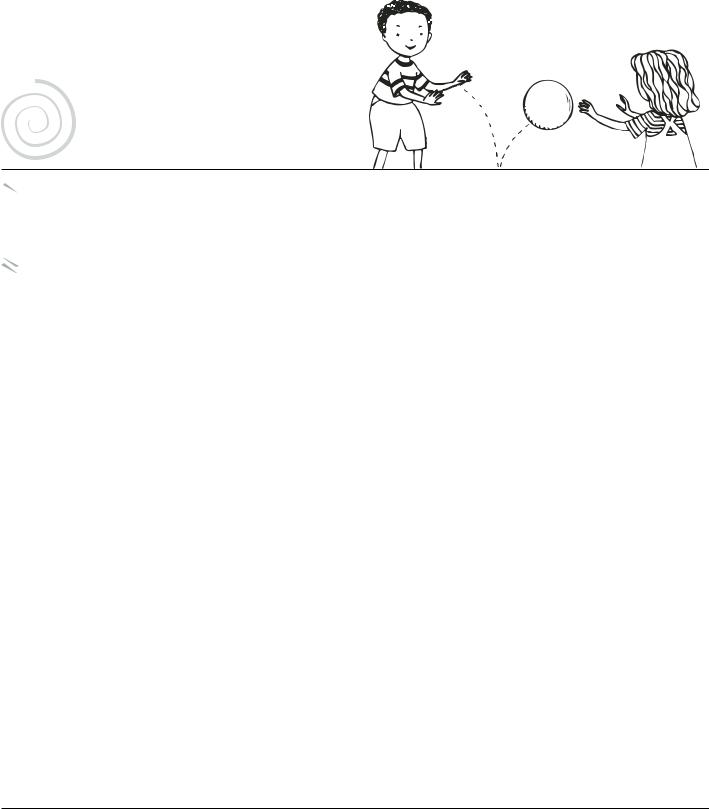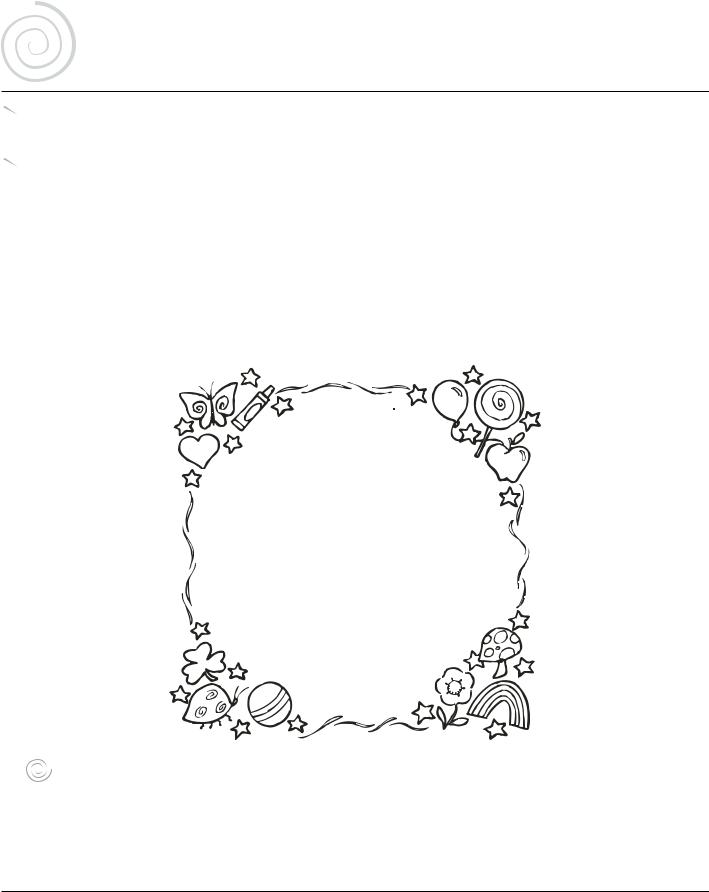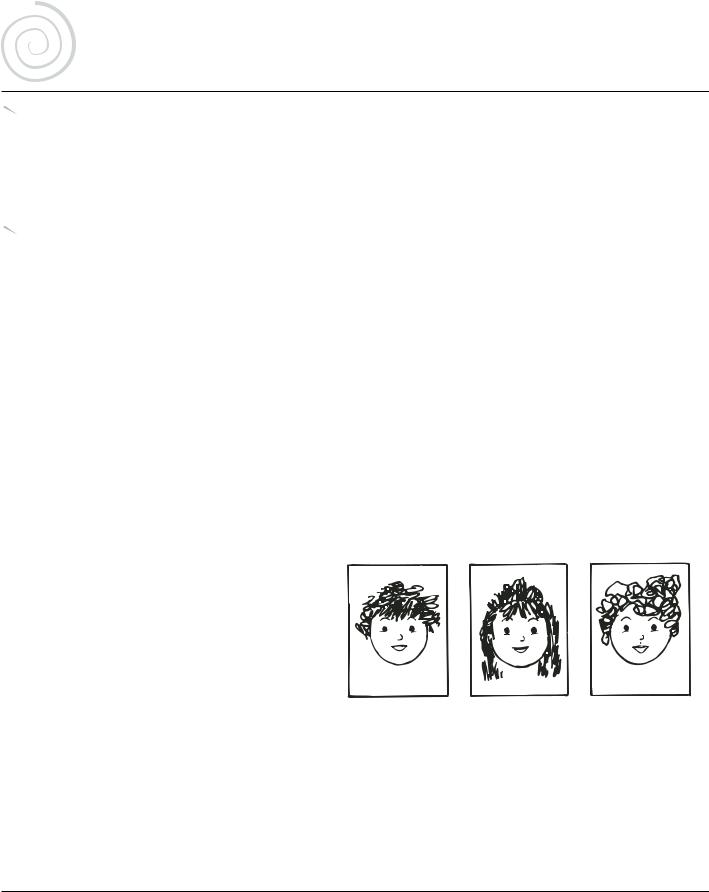
- •Table of Contents
- •Early Childhood
- •Introduction
- •Name Game
- •Up and Down
- •On the Outside
- •Rainbow Dolls
- •Responsible Me
- •The Mirror and Me
- •Positive Statements Poster
- •Talking Tube
- •The Circle of Noise
- •Happy Hands, Sad Hands
- •Feeling Faces
- •Knock, Knock
- •Friendship Ring
- •Language and Literacy
- •Wonder Why
- •What If?
- •How Many Ways?
- •Rhyming Riddles
- •Story Bag
- •Symbol Stories
- •Answers and Questions
- •Simon Says Opposites
- •Fun with Books
- •Nonverbal Communication
- •Words All Around Us
- •Alphabet Letter Magnets
- •Listen to the Sound
- •Math
- •Counting Song
- •Counting Catches
- •Number Match Game
- •Seasonal Number Rhyme
- •How Many?
- •Walk Around the Shape
- •Shapes in the Air
- •I Spy a Shape
- •Shape Bingo
- •Shape Dance
- •What Does It Weigh?
- •Lengthy Fun
- •Shape Patterns
- •Patterns in Sound
- •Science
- •People, Places, and Things
- •Same and Different
- •Bug in the Rug Game
- •Backwards Photos
- •Nature Walk Stories
- •Shadow Explorations
- •Buzz
- •The Fan Club
- •When We Were Small
- •What Is the Weather?
- •Time for Graphing
- •Sink or Float?
- •Qualities
- •Light Show
- •Music and Movement
- •Drumbeats Movement
- •Streamer Fun
- •Musical Instruments
- •Music Everywhere
- •High and Low
- •Music Detectives
- •Partners Move!
- •Moving with Scarves
- •Dance Fever
- •Visual Arts
- •Musical Collage
- •Puzzle Mural
- •Playdough Creation
- •Our Sculpture
- •Brick Building Mural
- •Sculpture Bags
- •Sticky Mural
- •Weaving Net
- •Chalk Pizza
- •Dramatic Play
- •Nursery Rhyme Fun
- •Space Adventure
- •Airplane Trip
- •Fly In and Out the Window
- •Pumpkin Patch
- •Row Your Boat
- •Mousy Moves
- •Sticky Story
- •Animals Sleeping
- •Football Practice
- •Motor Skills
- •Build a Tower
- •The Feather Dance
- •Fun with a Parachute
- •Beanbag Game
- •Hoops of Fun
- •Wading Pool Fun
- •Bubble Wrap Play
- •Dot-to-Dot Mural
- •The Friendship Squeeze
- •Musical Chairs and More
- •Moving with Carpet Squares
- •Walk the Line
- •Copycat

CHAPTER 1
Social and Emotional
Development
1 NAME GAME
 Materials
Materials
Large rubber ball
 Activity
Activity
Try this circle activity at the beginning of the school year to help the children learn one another’s names. Sit with the children in a large circle, making sure everyone has plenty of space. Show the children how to sit with their legs open in a V-shape. Hold a large rubber ball in your hands. Say your name and the name of one of the children, and then gently roll the ball to that child. Have that child say his or her name and the name of another child before rolling the ball to that child. Once a child has caught and rolled the ball, have the child sit cross-legged until everyone has had a turn. Then play the game again.
 Variation: To make the game simpler, have each child roll the ball back to you instead of to another child. Once the children have mastered the basics of the game, let them roll the ball to one another.
Variation: To make the game simpler, have each child roll the ball back to you instead of to another child. Once the children have mastered the basics of the game, let them roll the ball to one another.
 Variation: Instead of rolling a ball to one another, let the children toss a beanbag.
Variation: Instead of rolling a ball to one another, let the children toss a beanbag.
 Extension: Challenge the children to pass the ball to one another as quickly as possible. Use a timer each time they play the game. Talk about playing quickly but carefully so that the ball does not roll out of the circle. Keep a chart with their times written on it. Ask the children, What was your shortest time? What was your longest time?
Extension: Challenge the children to pass the ball to one another as quickly as possible. Use a timer each time they play the game. Talk about playing quickly but carefully so that the ball does not roll out of the circle. Keep a chart with their times written on it. Ask the children, What was your shortest time? What was your longest time?
 Extension: Use this game format to learn new things about the children. For example, in addition to having the children say their names, have them say how old they are, what their favorite color is, what they like to eat for breakfast, or some other interesting fact about themselves.
Extension: Use this game format to learn new things about the children. For example, in addition to having the children say their names, have them say how old they are, what their favorite color is, what they like to eat for breakfast, or some other interesting fact about themselves.
© School Specialty Publishing |
7 |
1-57029-486-0 101 Circle Time Activities |

Social and Emotional Development
2 UP AND DOWN
 Materials
Materials
Carpet squares
 Activity
Activity
This circle time activity is a great way to practice the children’s names and to help them expend extra energy in an appropriate way. Place carpet squares in a circle, making sure there is one square for each child. Invite the children to sit on the carpet squares. Begin by singing the first two lines of the following song, substituting the name of one of the children for Alex. Have the child who is named stand in the middle of the circle. Continue with the rest of the song, having the child in the middle act out the motions as they are described in the song. At the end of the song, have the child sit down. Begin singing the song again, naming a different child to stand in the middle of the circle. As the children become familiar with the song, encourage them to sing along with you. Repeat until each child has had a chance to stand in the middle of the circle and act out the motions.
Sung to: “Twinkle, Twinkle,
Little Star”
At our school are many friends,
And Alex is one of them.
He can hop and he can bow.
He can turn around right now.
He can show us marching feet.
Now, please, Alex, take your seat.
Gayle Bittinger
Variation: To encourage listening skills with this activity, change the movements each time you sing the song.
© School Specialty Publishing |
8 |
1-57029-486-0 101 Circle Time Activities |

Social and Emotional Development
3 ON THE OUTSIDE
 Materials
Materials
Four vases
Four mirrors
 Activity
Activity
Learning to respect one another’s differences is what this activity is all about. Have the children sit in a circle. Place four different vases in the middle of the circle. Ask the children to tell you what they are. Let them tell you how each vase is different from the others. Then ask the children if one vase is better than another for holding flowers. Encourage the idea that even though the vases are all different, they can all hold flowers. Repeat with four different hand mirrors, reinforcing the idea that while the shape or appearance of each mirror might be different, each one still shows your reflection.
Now have all the children stand. Ask them if they notice anything about their body shapes—each child has his or her own special shape. Lead them to the conclusion that while each child might have a different shape, each one is a person who is special and needs to be respected. Encourage the idea that liking someone and being kind to him or her should not depend on that person’s shape or appearance. Sing the following song to reinforce the idea that each person is special in his or her own way.
Sung to: “The Farmer in the Dell”
I look just like me,
And you look just like you.
We all look just like ourselves.
Each one is special, too.
Gayle Bittinger
Extension: Let the children continue this concept at a table where a variety of cookie cutters have been set out. Point out that while each cookie cutter looks different, they all do the same job of cutting out shapes. Give each child some playdough. Let the children flatten the dough and use the cookie cutters to cut out a variety of shapes.
© School Specialty Publishing |
9 |
1-57029-486-0 101 Circle Time Activities |

Social and Emotional Development
4 RAINBOW DOLLS
 Materials
Materials
Plain paper
Black marker
Tape
Crayons
 Activity
Activity
Respecting others is a big concept for young children. This activity teaches respect through stories and a child-created visual aid. For each child, draw a doll face without its hair on a sheet of plain paper. Tape the faces in a row on a wall at the children’s eye level. Have the children sit in a circle. Talk about what it means to respect someone. Explain that respecting a person means appreciating and valuing the things that make him or her special, even when those things seem different to you. It means treating people nicely. Tell the children short stories about children playing together: Katie wants to play on the swings, but Jason won’t let her because she has a red shirt on. Dustin is playing blocks with three other boys. When Allie wants to play with them, he invites her to join them. Encourage the children to think of other pretend situations like these. Have them tell you which children are being respectful and which ones are not.
Now have the children look at one another. Encourage them to notice how the other children look different from themselves because of different hair, clothes, body shapes, height, and so on. During their observations ask the children questions about respecting one another. Foster the idea that people should be respected no matter what they look like.
Set out crayons in a variety of rainbow colors. Let each child select a crayon to use to color in the hair on one of the doll pictures you have hung on the wall. When everyone is finished, look at all the dolls. Ask the children if all of the dolls look the same. Should the blue-haired doll feel she is better than the green-haired doll? Should the pink-haired doll respect the purple-haired doll? Reinforce the concept that each doll or person is special and different, and each should be respected.
© School Specialty Publishing |
10 |
1-57029-486-0 101 Circle Time Activities |

Social and Emotional Development
5 YES AND NO
 Materials
Materials
Red and green construction paper
Scissors
Marker
 Activity
Activity
Expressing your own opinions and respecting others are at the heart of this activity. Before the activity begins, cut red and green construction paper into fourths to make small signs. Use a marker to write “Yes” on all the green signs and “No” on all the red signs. Make a green and a red sign for each child.
Have the children sit in a circle. Discuss opinions with the children. Explain that an opinion is the way a person feels about something; it isn’t something that is right or wrong. Explain that different people have different opinions. We should all respect one another’s opinions even when they are not the same as ours.
Now let the children explore their own opinions and discover how they are alike or different from everyone else’s. Pass out a green “Yes” sign and a red “No” sign to each child. Have the children hold their signs in their laps. Then ask the children a “yes” or “no” question such as the following:
Do you like animals?
Is pink your favorite color?
Is pizza the most delicious food you’ve ever tasted?
Do you like to go swimming?
Would you like a dog for a pet?
Would you like to fly in an airplane?
Do you like snowy days the best?
At the park, do you like swinging on the swings the most?
Would you like to ride on a train?
Have each child hold up the sign that describes how he feels about the question. Count the green signs and the red signs. Have the children look around. Ask them if all their friends have the same opinion as they do. Reinforce the idea that people have different opinions about things and that their opinions should be respected.
© School Specialty Publishing |
11 |
1-57029-486-0 101 Circle Time Activities |
